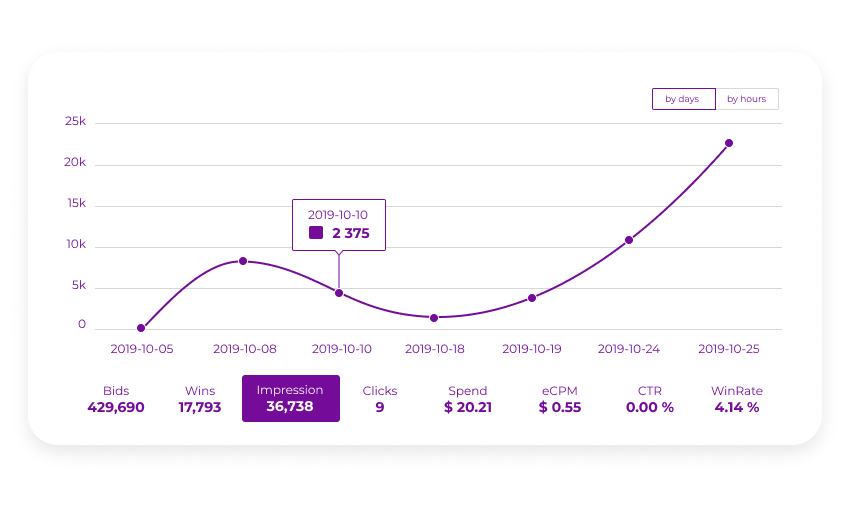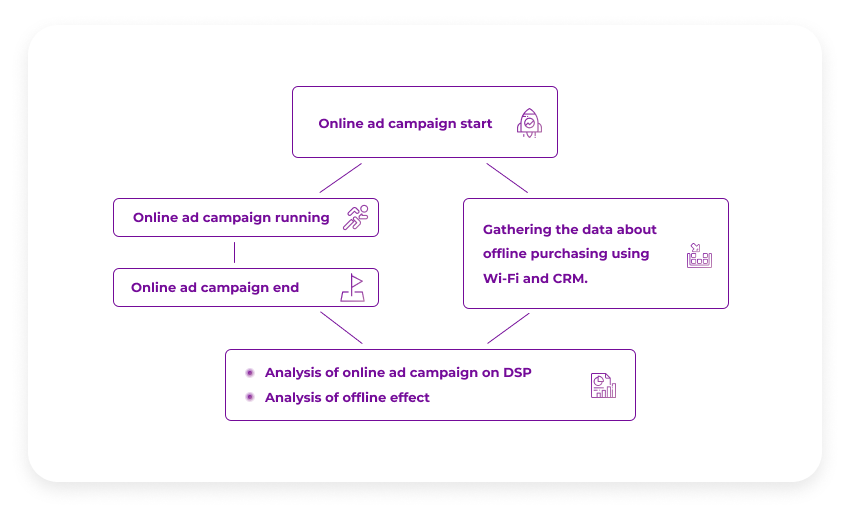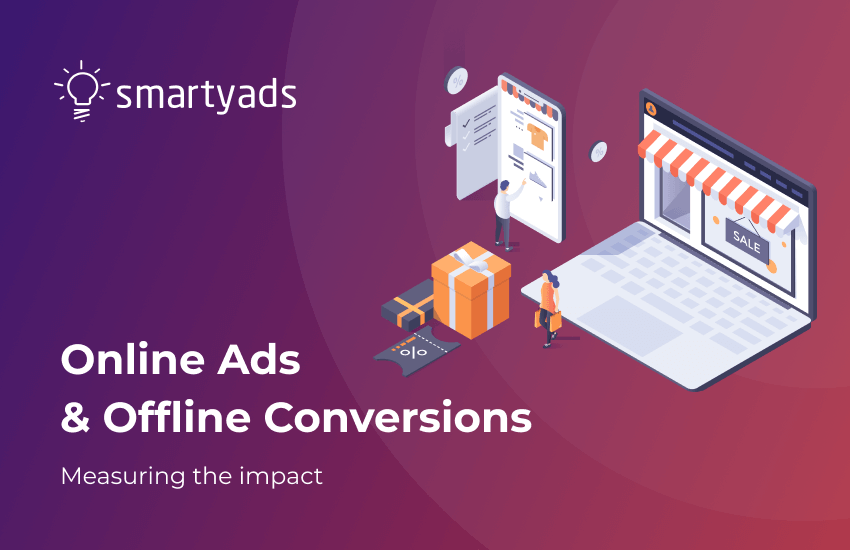Try to recall your own online shopping habits, the odds are high, in certain cases you still prefer to shop at a brick-and-mortar retail store after watching a digital ad. This pattern of customer behavior is called the ROPO effect (purchase offline - "search online, buy offline") and it takes place across various business verticals.
The thing is, technologies like addressable TV advertising, social commerce, voice commands, AR and VR are gaining traction and soon they will define the future of digital advertising. The shoppers are getting more demanding regarding where and when they consume and stream the content. Such a situation drastically affects the communication effect, since brands, agencies, and solutions of the programmatic ecosystem are trying to reach the customers on a multitude of platforms: mobile, in-app, desktop, CTV.
Sure, modern customers are going omnichannel, but surprisingly, a certain share still prefers offline shopping experience. In order to properly evaluate the results of advertising campaigns, businesses need to know how to measure advertising effectiveness on DSP and pinpoint how their brand awareness campaigns impact offline sales.

Advertising effectiveness research: Online vs offline purchases
Advertising effectiveness research held by INFORMS journal Marketing Science states: online display digital ads significantly increase both online and offline sales for a retailer. In fact, more than 80% of digital and programmatic online ads drastically enhance offline sales, even if those are not performance-based campaigns but brand-awareness ones.
Even though eCommerce purchasing grows tremendously, brands that build their image around personal user experience are also trying to establish an offline presence. Why does that happen? Brick-and-mortar stores give brands an opportunity to engage with their customers. Furthermore, retailers achieve the best yields combining online mobile marketing campaigns with in-store purchasing processes, as stats show.

Advertising effectiveness statistics and offline purchasing
In 2019, 57% of customers made purchases online, around 31% of users gave preference to purchasing from brick-and-mortar shops, and 12% used both ways. The benefits of online purchasing are floating at the surface, the questioned customers report that among those are: Ability to buy something 24/7 (32%) Lower prices (29%), Convenience (22%) Time-saving (17%) Those people that opted for offline purchasing explained their decision-making by:
- Ability to test and try the product (51%)
- Experiencing physical shopping experience (24%)
- Fast product purchasing (without waiting for delivery) (4%)
In 2019 90% of retail sales in North America were made in stores, five years from now this percentage will still account for at least 80%. This testifies to the fact that offline purchasing isn’t going anywhere even though digital marketing and advertising almost completely went online.

Advertising effectiveness measured on DSP
In case you already run a programmatic advertising campaign, you know what is a DSP demand-side platform and the benefits of CPM advertising (cost per mille pricing model). So, if the effectiveness of an advertising campaign can be measured on DSP, you need to define campaign objectives before you launch a campaign.
In comparison to other advertising pricing models CPM considered to be the most affordable solution applied by the majority of programmatic advertising platforms. Whereas in the CPC (cost-per-click) model advertiser pays for the fixed amount of clicks, in CPM advertiser pays for 1000 impressions, no matter how many clicks those impressions generate. If chosen digital ad formats and creative messages are original and compelling enough, such impressions are triggering a lot of clicks that in the end come for much cheaper price compared to CPC.
On DSP you can see the dynamics of your CPM campaigns' during custom time periods and generate the freshest stats in real-time, regarding:
- Number of impressions & conversions
- Change in eCPM
- How much you spend on the campaign, etc.
As well, SmartyADs DSP enables advertisers to analyze extended performance criteria: Bids, Wins, Impressions, Clicks, eCPM, CTR, WinRate and delivers stats in the easily digestible graphs that can tip you off if your digital ad campaign needs a change of course.

Next challenge: Attributing offline conversions to online campaigns
How to measure advertising effectiveness on sales if they take place offline? It is a big challenge and must for every company. Measuring the effectiveness of offline conversions will help you to run better and more opaque analytics on your advertising campaigns. If you do not collect the offline data after the end of a digital advertising campaign, the statistics may turn out to be incomplete, and the advertising campaign results - undervalued. Collecting offline customer data, you can identify those who have made the purchase decision after viewing the ad but visited a store instead.
The advertiser/brand needs to collect the data about purchases and visits after a while (after the ad campaign has ended). For this, you can use CRM data and data gathered from wifi-analytics. The data from wi-fi analytics and CRM can then be integrated into your ad tech and mar tech tools via API in order to complement online analysis.
Wi-Fi analytics
Install Wi-Fi routers in your brick-and-mortar store. These routers should have sensors that collect MAC addresses (unique identifiers of mobile devices). This way you will attribute the visitors who watched your ads but came to purchase offline.
Collect CRM data CRM
Data may also be suitable for measuring the effectiveness of advertising in offline stores. In this case, you need to manually enter the mobile phone numbers and e-mail addresses of buyers who purchased in store after watching ads.
Typically, the offline sales attribution window should be opened after the campaign on DSP has ended. Attribution window is a time that passes from the point when a user first interacts with ad to the time when they make a target action (purchase).
Advertising effectiveness statistics claim: the attribution window is directly proportional to the cost of the product: the more expensive the product, the longer the user makes a decision. For instance, it typically takes 3-7 days for the person to make a decision about purchasing clothes or a book, while purchasing an apartment may take up to 5-6 months.

Mapping customer journey with tags
A successful marketing strategy should also take into account the analysis and measurement of the entire customer journey: from the point the user first sees the ad to the moment the purchase is done. That’s why marketers who really want to map customer journeys often apply additional ways of conversion attribution for creatives. The more successful creative will be, the more beneficial your CPM campaign will be, as a result, it will bring more online and offline conversions. How to find out if your creative performs just well?
On SmartyAds DSP advertisers can apply JS Tags, Iframe, HTML Tags, VAST, VPAID, MRAID and third-party tags for creative performance of which they want to track. Applying creative tags advertisers can understand how their customers interact with messages, reveal potential pitfalls, areas for improvement, and eliminate impression discrepancies. Read about difference between VAST and VPAID in our related article.
The last word
Measuring advertising effectiveness can be tricky: while mar tech and ad tech tools retrieve a precise picture regarding your ad performance, it is hard to match digital effectiveness with actual sales. As you consider your next advertising strategy, remember how important it is to measure both effectiveness of the campaign on DSP and the impact of digital ads on offline sales. Generate stats in real-time on DSP, use tags for in-deep creative analysis, and combine it with offline campaign attribution tactics to measure the success of advertising strategy.
Plan, execute, and analyze highly-converting ad campaigns on SmartyAds DSP!





